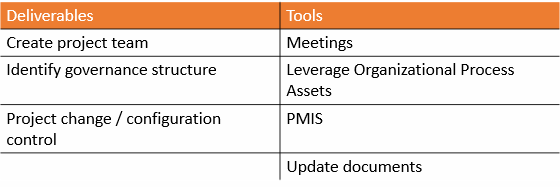Establish project governance structure
Enablers
- Determine appropriate governance for a project. (ECO 2.14.1)
- Define escalation paths and thresholds. (ECO 2.14.2)
Deliverables, and Tools

Project Governance
Project governance * is the framework, functions, and processes that guide project management activities in order to create a unique product, service, or result to meet organizational, strategic, and operational goals.
Project Governance Framework
Components of the framework can include:
- Project success and deliverable acceptance criteria.
- Process to identify, escalate, and resolve issues.
- Relationship between project team, organizational groups, and external stakeholders.
- Project organization chart with project roles.
- Communication processes and procedures.
- Processes for project decision-making.
- Guidelines for aligning project governance and organizational strategy.
- Project life cycle approach.
- Process for stage gate or phase reviews.
- Process for review and approval of changes above the project manager's authority.
- Process to align internal stakeholders with project process requirements.
Project Phases
A project phase * is a collection of logically related project activities that culminates in the completion of one or more deliverables.
- Produce one or more deliverables
- Can be performed sequentially or can overlap
- Outputs from one phase are generally inputs to the next phase
Applying Governance to the Project Life Cycle
- At the beginning of each phase, it is a good practice to verify and validate the former assumptions made to the project, analyze risks, and explain in detail the processes required to achieve a phase’s deliverables.
- After the key deliverables of a particular phase are produced, a review at the end of the phase is necessary to ensure completeness and acceptance.
- Even though this method signifies the start of the subsequent phase, a phase can be closed or the project terminated when huge risks are involved for the project or when the objectives are no longer required.
Escalation Paths
A phase gate * is a review at the end of a phase in which a decision is made to continue to the next phase, to continue with modification, or to end a project or program.
- Synonyms include governance gate, tollgate, and kill point.
- Used to check if each phase has fulfilled the exit criteria and is eligible to move to the next step.
- Software development projects use a specialized type of phase gate called a quality gate.

Phase-to-Phase Relationships
- Sequential relationships contain consecutive phases that start only when the previous phase is complete. This relationship reduces the level of uncertainty, which may eliminate the option for shortening a project's schedule.
- Overlapping relationships contain phases that start prior to the previous phase ending. This relationship increases the level of risk and may cause rework if something from the previous phase directly affects the next phase.
Guidelines to Determine Appropriate Governance for a Project
- Involve the organization’s decision managers, who are frequently its senior managers.
- Choose the most appropriate governance goals, and try to keep them simple.
- Select a group of experienced individuals to be responsible for all governance activities.
- Practice governance for projects, programs, and portfolios.
- Keep the governance process transparent to the project stakeholders.
- Remember that governance is an evolutionary process, and take advantage of the lessons you have learned during it.